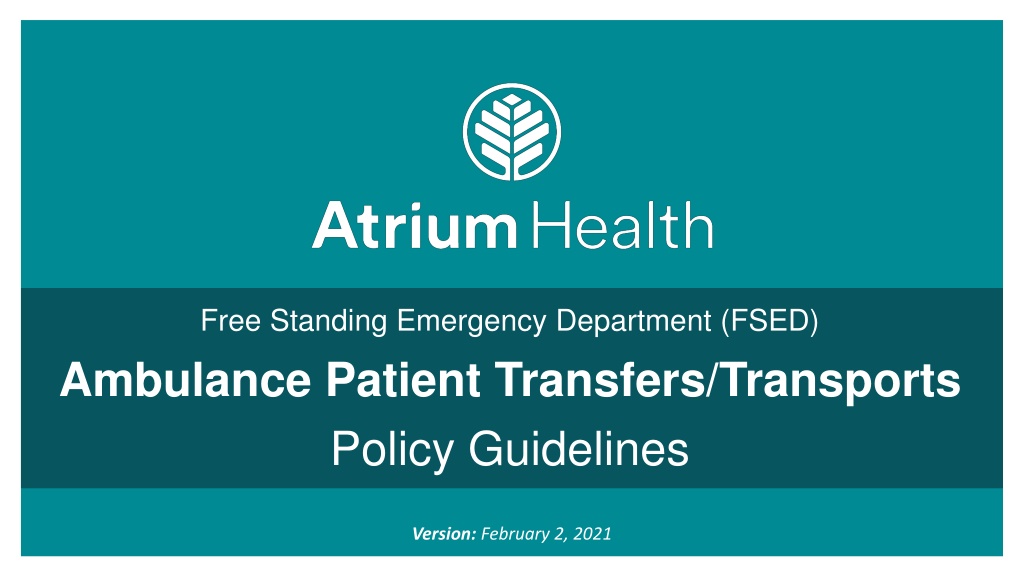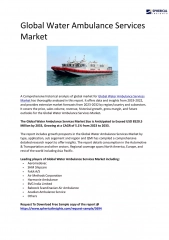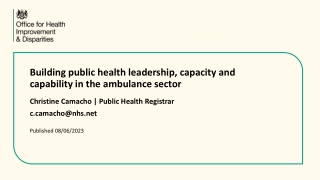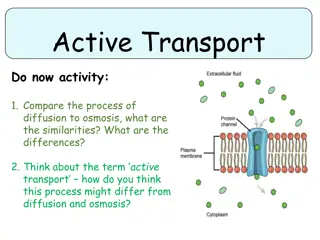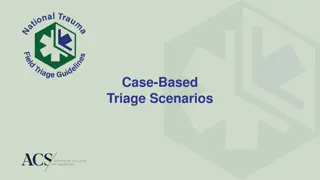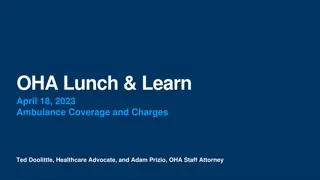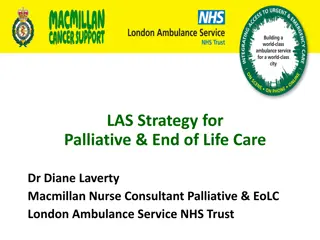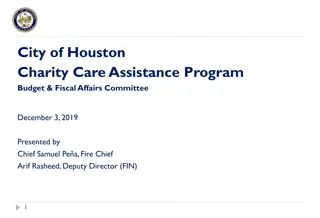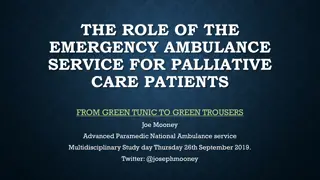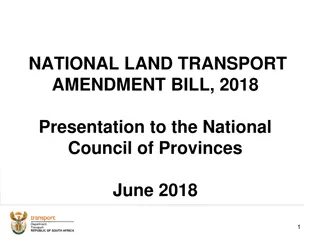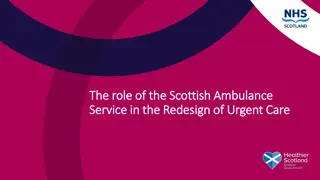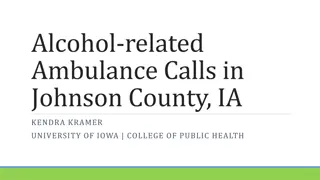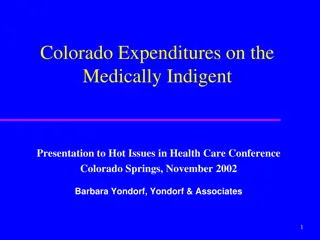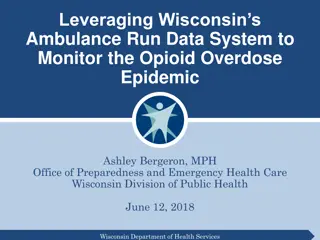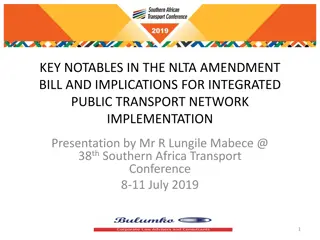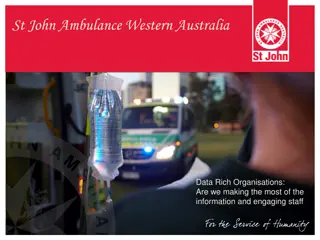Understanding Medically Necessary Ambulance Transport Guidelines
This comprehensive guide discusses the importance of medical necessity for ambulance transfers, criteria for determining when ambulance transport is required, and the impact on patients and healthcare facilities. It covers types of ambulance transports, roles of physicians in evaluation, and the necessity of ensuring patient conditions meet required criteria. Additional resources and guidelines are provided for healthcare teams to facilitate proper decision-making regarding ambulance transfers.
Download Presentation

Please find below an Image/Link to download the presentation.
The content on the website is provided AS IS for your information and personal use only. It may not be sold, licensed, or shared on other websites without obtaining consent from the author. Download presentation by click this link. If you encounter any issues during the download, it is possible that the publisher has removed the file from their server.
E N D
Presentation Transcript
Free Standing Emergency Department (FSED) Ambulance Patient Transfers/Transports Policy Guidelines Version: February 2, 2021
What You Need To Know? Table of Contents Why is this important? What is medically necessary for ambulance transfers/transports? What are the criterion for medical necessity? What is your role in making this determination? If not ambulance, then what? Know your options Additional Resources for Your Care Team
Impact to the Patient Understanding Medical Necessity Huge patient dissatisfier if/when they get billed for an ambulance ride that was not necessary- it s not cheap! Impact to Atrium For patient ambulance transfers/transports SAMPLE from existing data: October 2020: $20,102 in unclaimed billings Patient satisfaction/reputation is compromised Why does this matter? We must ensure patient s conditions meet medical necessity criterion to determine if ambulance transport is reasonable and necessary. Important: The medical necessity criterion included in the following policy guidelines are established by the Centers for Medicare/Medicaid (CMS).
Medically Necessary Ambulance Transport/Transfer: Types of Ambulance Transports and Transfers An ambulance service is medically necessary when the patient s condition is such that the use of any other method of transportation is contraindicated. Key Terms Role of the physician/APP: You must evaluate patient s condition and determine that ambulance transport is reasonable and necessary and that transporting the patient by a means other than ambulance method of transportation is not appropriate and will endanger a patient.
Non-Medically Necessary Ambulance Transport/Transfer: Types of Ambulance Transports and Transfers Ambulance services are not medically necessary when the patient s medical condition does not warrant the use of an ambulance and that ambulance transport is not reasonable and necessary. Key Terms Role of the physician/APP: You must evaluate the patient and determine that transportation other than by ambulance is appropriate and will not endanger the patient.
Access the Transfer & Transport Request Form For Physicians & APPs (via Canopy) Why is this required? Access the Job Aid To initiate a non-emergent patient transfer/transport or to consult with another Physician using Physician Connection Line (PCL), complete the Transfer & Transport Request form in Canopy. After completing the form, PCL will contact you. If an EMTALA is required, complete the EMTALA Form (instructions included in the PDF below). Emergent Transfer Options 1. Consultation through the e-form link below for PCL. 2. Call PCL directly at 704-512-7878. The new Physician Connect Line (PCL) patient transfer/transport/consult process eliminates calling PCL to initiate the transfer/transport. You no longer are required to call PCL to initiate a patient transfer, transport, or consult. Initiate the process by completing a Transfer & Transport Request and, if required, the EMTALA form in Canopy. The Transfer & Transport Request is forwarded to PCL who will conference call you (the requesting Physician) with the receiving Physician/APP to determine how to proceed. Launch the FAQ for more information! A picture containing text, sign, vector graphics Description automatically generated
Designate the medical necessity of the transport BEFORE you send in an ambulance! Criterion for Medical Necessity Do at least one of these accurately reflect the patient s condition? CONFIRM: Advanced Life Support (ALS) monitoring required Monitoring Required Bed confined at the time of transport Medical condition that contraindicates transport by other means Did they meet 1 or more criterion? Ensure you are completing the electronic transfer request form. In emergency situations call PCL directly: 704-512-7878 Icon Description automatically generated CTRL+Click the Download icon to view medical conditions that satisfy the criterion above
What IS NOT Medically Necessary? Below are some potential scenarios where a patient WOULD NOT qualify as medically necessary for an ambulance transport and transfer A stable pediatric patient transferring for an appendectomy or orthopedic consultation with a legal guardian who can drive them. A stable patient with an extremity fracture who has a safe ride to the facility. Patient who is requesting an ambulance ride but does not meet any medical necessity criterion.
Wheelchair Van Verify: Patients must be medically stable. Strictly for patients (i) who need assistance due to being confined to a wheelchair and (ii) who will have no other medical needs during transport Patients may have medical devices or oxygen if they are on their normal home requirements and not newly initiated at FSED. What are my options for patients who do not require an ambulance? Atrium Contracted Ride Share Service Verify: Patients must be medically stable. No other criteria for this alternative method. Only use Atrium approved services via Circulation Note: Designees with access to Circulation may vary based upon your facility (For Example: Nursing and/or Social Work teammates typically have access.) Verify: The patient must be determined to be medically stable by the sending physician and may not drive himself/herself. Patient must identify who will be driving him/her. The name/relationship to the driver of the personal vehicle should be documented in the patient record. Examples of eligible patients: Require minimal assistance, i.e., patient is able to walk (use of cane or walker) to and from vehicle. Need intravenous access as long as the access was not newly placed at FSED or that the administered medications does not require patient monitoring. Require oxygen as long as the patient is on their normal home requirement and not newly initiated at FSED. Has medical devices as long as the patient is on them at home and self-managed. Electronic Transfer Form MUST be completed when using Alternative Methods of Transportation Patient is driven in a personal vehicle
Alternative Methods of Transportation Additional Actions & Associated Costs Circulation- Atrium Contracted Ride Share Service Patient is driven in a personal vehicle Wheelchair Van Additional Actions: What do I need to do? Ensure transport voucher for Atrium Health Passenger Services is completed and faxed to: 704-446-4191. Complete ETRF form Ensure the Personal Transportation AMA form has been completed and patient has signed it. Schedule via Circulation Varies by facility, see your nursing and/or social work teammates to schedule. Associated Costs: For Atrium Health Facility And/or patient Referring Atrium Health Facility will be billed for the service. Referring Atrium Health Facility will be billed for the service. Patient Responsibility
Common Myths About Medical Necessity & Ambulance Transfers and Transportation EXAMPLE 3 EXAMPLE 1 EXAMPLE 2 I can always select a patient transport via ambulance because insurance always covers these transfers and transports. My patient will not pay if we request an ambulance transport or transfer because they meet medical necessity criterion. Everyone who needs to be admitted to the hospital should be sent there by ambulance transportation. WRONG WRONG WRONG Unnecessary ambulance transportation puts Atrium at risk for fraud under the False Claims Act. This can be a patient dissatisfier, if the transport is not medically necessary and they receive an unexpected bill (For example to include co-insurance and deductible). The patient must meet medical necessity criterion to determine if ambulance transport is reasonable and necessary. The patient s individual insurance coverage will determine any payment required of the patient, even if medical necessity is validated.
Additional Resources References: 42 CFR 410.40 Ambulance Fee Schedule and Medical Transports MLN Booklet Medicare Benefit Policy Manual Chapter 10 Medicare Claims Processing Manual Chapter 30, Section 50, Subsection 15 eLearning Module (Interactive Video; Mobile Friendly): Electronic Patient Transfer Process (for Nursing) Patient Questions and Complaints: Patients with questions regarding ambulance related costs should be provided with the FSED Patient Transfer FAQ document before making a decision about their transportation. Patient complaints regarding ambulance bills received by the FSED department managers should be directed to xmcabilling@atriumhealth.org for resolution.
